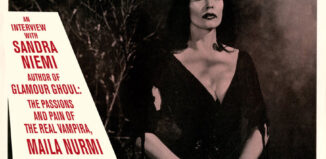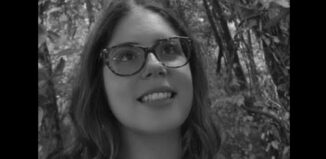The Art Collective
by Robert Boucheron
Swathed against the November chill in a woolen wrap and a silk scarf, still chic in her fifties, Nora Devereux made her way along Main Street. She walked every day, no matter the weather. The historic district, built in the late 1800s, offered endless vignettes—the intrigue of a cobbled alley, the thrust of a turret, a mask molded in terra cotta.
Down a side street, Nora spotted something called the Art Collective. The grand old building had arches, carved keystones, and a beetling cornice. She detoured and peered in the storefront. The space was bare—white walls, a polished hardwood floor. Track lights hung from a high ceiling, bright as diamonds.
A thin woman seated at a small pine table caught sight of Nora and waved her arms over her head, as though drowning. She wore a long skirt, a bunchy sweater, and a loop of beads that dangled from her neck. No one else was visible in the space. The gesture was not a cry for help but an appeal for company.
Nora pushed through the glass door. The woman popped up, and her bob of gray hair flew.
“Welcome to the gallery! The Art Collective is owned and run by a group of local painters, sculptors, photographers, and what-have-you. Many of the members are older and retired, including some retired art teachers. I’m Helen Tabasco, the artist on duty. Please look around, and if you have any questions, I’ll try to answer.”
“Thank you,” Nora said. “I’m retired, too.”
Trying not to ignore the artist on duty, Nora glanced right and left. The white walls displayed framed watercolors, sketches, collages, paintings, and photographs. Small ceramics of uncertain shape reposed on large white blocks. Here and there stood sculptures made from scraps of wood and metal, like primitive robots or post-industrial idols.
“Are you represented here somewhere?” Nora asked.
“Yes! Look for the big arrow.” Helen Tabasco pointed. High on a wall was her name in block letters with a cardboard arrow stuck beside it. Five canvases hung below. Nora felt obliged to take a closer look. Her heels clacked on the hardwood floor, and Helen followed in staccato counterpoint. In planes of orange, yellow, azure, and dark blue, the canvases were geometric views of a village in dry country. Cubism happened a hundred years ago.
“Very interesting,” Nora murmured. She moved to the next artist, and the next. Helen was always few steps behind, tethered by an invisible lifeline. A telephone rang on the small pine table.
“Excuse me,” Helen said. “I ought to answer that.” She hurried away.
One side of a long conversation rang through the empty gallery. The subject was troubling, something to do with illness, a prescription to be refilled, and a cranky patient. Known only as “he,” the patient had accidents that required cleaning up after. Was he a dog or an incontinent senior citizen?
Nora did her best to ignore this as she gazed. Strangely, nothing in the gallery reflected the wealth of architecture just outside the door, or the gardens and farms nearby. There were blurred portraits, bowls of fruit in unnatural colors, abstract splashes of black and blood red, and vistas of unremarkable hills. Street scenes reproduced a tangle of overhead wires, parked cars, and dented trash cans. The photographs were doctored, made grainy or dim, as if to disguise their bland subjects—a leafless tree, a railroad track. Artist names were posted above in bold type. Everyone got a few square feet of wall space, and a Featured Artist had a spread near the front.
Nora gave each artist a minute and moved on. She was grateful not to have to talk. Truthful impressions were hazardous. Yet the gallery cast a kind of spell, like the stage of a theater. It made you want to believe.
Nora worked her way back to the street door. A pocket of flyers hung there, and a neatly lettered sign was taped to the glass. The sign read:
The Art Collective is in search of talented individuals to join and exhibit their work for sale. Please take a flyer. Or call this number and leave a message. Or visit our website for rules, procedures, and a new member application.
Helen Tabasco was still on the phone. Unable to desert her post, she grimaced with regret. Nora took a flyer, waved goodbye, and exited. The flyer explained:
Each member pays an annual fee and volunteers to staff the gallery twice a month. A portion of each sale goes to the gallery to pay rent and utilities. Members and their guests meet a few times each year for events like lectures and special exhibits. The month of December is the busiest, as people shop for Christmas.
Nora had drawn with pencil and pen ever since childhood. Art teachers complimented her sense of proportion and distribution of light and dark. As an adult, she drew what struck her as funny or sad. They were quick sketches, done in an hour or two. She carried a pad and pencils in her bag. Weather and kibitzers could be overcome. She tried once to draw an old chair from memory and gave up halfway. Now she snapped a photo for later.
Nora sometimes gave a drawing to a friend. She had not shown or sold her work. Until now, the idea never occurred to her. She had never taken an adult art class, and she was not sure she felt up to it.
Could I learn how to paint? Nora asked herself. Do I have the patience to devote days to a single canvas? Where would I find a studio? My sketches are at least as good as what was on view. Maybe I should give it a try. If nothing else, I’ll have a new activity, meet new people. Volunteer for the cause of art.
The gallery asked to see four or five samples with the application. In a tattered portfolio, Nora found a dozen or more drawings. She spread them on the floor of the apartment. They were of different sizes, drawn on different kinds of paper. How to choose? Should there be a theme to tie them together? Did they need to be framed? Custom framing was expensive. Ready-made frames that came with the glass and mat already cut might be acceptable.
Over the next few days, Nora tiptoed around the living room. She rearranged the drawings, set some aside, and stepped on one by accident. It was creased, not ruined. Maybe it gained in character. In the end, she settled on four drawings that had nothing in common—a seedling in the crotch of a large tree, a shed built of discarded doors and windows, a pigeon soliciting a toddler who had a cookie, and a street vendor of scarves bundled up in her own merchandise.
At an art supply store, the choices were overwhelming. After an hour of comparison, Nora found a plain black frame and bought four. Home again, she assembled the artwork on the kitchen counter. As she worked, she wondered. How many drawings had she given away, and what had become of them? All that was out of her hands. At the last minute, Nora swapped the street vendor for a poodle in a perambulator, with a ribbon in a bow on its curly head.
The application asked for a name and address, media used, and any previous exhibitions. That much was easy. At the bottom, Nora read this:
Please attach an Artist Statement, or respond to these questions. What style best describes your art? How does the visual intersect the psychological? Where does it fit in the realm of phenomenology?
Nora was stumped. She looked up “phenomenology,” but the definition was as opaque as the word, something to do with perception. At the public library, she browsed back issues of Art in America in the hope of picking up the lingo. “Line” seemed to be important, along with “profile” and “form.” She liked the adjectives “intuitive” and “spare.” That evening, she tried various combinations and ended up with this:
My work is grounded in the purely visual, without distractions of theory or interpretation. The line is intuitive, and the line is spare. The line marks the boundary of form implicit in the profile. Perception is profile, after all.
The next day, Nora slipped the application and the four framed drawings into the bag from the art supply store. With this bulk under her arm, she walked to the Art Collective. A week had passed. Helen Tabasco was again on duty.
“I’m here most Saturdays, except when I drive my husband to chemotherapy.”
Nora explained her errand.
“Wonderful! I’m also on the review committee. May I?” She reached eagerly into the bag and laid the framed drawings on the table. “Oh, these are very good! I see no objection to admitting you as a new member.”
“When does the review committee meet?” Nora asked.
“There’s no set schedule. You’re the first to apply.” Helen returned the drawings to the bag and placed it on a large white block behind her. A sculpture pedestal, Nora thought, or an altar.
“Do I need to appear before the committee?”
“Not that I know of. The others will come by and take a look. At some point, we will talk to each other.”
“Will someone phone me?”
“I suppose. It’s hard to say exactly what will happen.”
This vagueness was far from reassuring. On the other hand, Nora had nothing to lose. She wandered the galley, and Helen returned to a large book that lay open before her, a book on the Desert Southwest.
Nora gazed without seeing anything distinctly, as though struck senseless in the presence of art. A few minutes brought her to the door. She waved farewell and hallooed.
“Thank you!”
Helen looked up in alarm from her reading. Then she recovered.
“Good luck!” She hallooed back.
A week passed. Caught up in errands and holiday anticipation, Nora forgot about the gallery. It was off the beaten track, hidden on its side street. Another week passed.
In December, happening to be on Main Street where she first saw it, Nora detoured again to the Art Collective. A different artist was on duty, a petite young woman with a striking figure, all in black. She wore a sleek silver necklace. She projected cool detachment. She did not stir as Nora approached the small pine table.
“Good afternoon, I’m Nora Devereux.”
“Astrid Unger. Can I help you?”
“A few weeks ago, I left an application and some of my drawings here. Has the membership committee reviewed them?”
“I don’t know anything about it.”
“Helen Tabasco was here at the time.”
“Oh, yes. She had to drive her husband to a medical appointment.”
“She said she was on the committee and it was likely they would approve.”
“Did she? That dingbat.”
“Excuse me?”
“Helen Tabasco gets confused. She has no authority to speak for the gallery.”
“Is the Art Collective welcoming new members?”
“We’re busy right now with the holiday season.”
Looking beyond Astrid, Nora spied her bag on the pedestal, untouched. A couple entered the gallery from the street. Astrid stood and went to greet them. As soon as they were occupied, Nora slipped behind the table.
The four framed drawings and the application were in the bag. Astrid chatted with the couple, well-dressed and middle-aged. The man held a lidded paper cup in front of his chest like a sacred object. The three took no notice as Nora tucked the neglected offering under her arm and walked briskly to the door.
In the street, festive lights twinkled in the early winter dusk. Nora released a sigh, a wisp of vapor that instantly fled. She distanced herself from the gallery.
A narrow escape, she thought. She could not have said from what, and nobody would ask. She refused to let the incident bother her. Still, what would become of poor Mr. Tabasco?
BIO

Robert Boucheron is an architect in Charlottesville, Virginia. His stories and essays appear in Bellingham Review, Fiction International, London Journal of Fiction, Saturday Evening Post, and online magazines.
Robert grew up in Syracuse and Schenectady, New York. His academic degrees are Harvard University, B. A. in English, and Yale University, M. Arch. He is an architect in Charlottesville, Virginia, where he has lived since 1987. His stories and essays on architecture and literature are in Bellingham Review, Fiction International, London Journal of Fiction, Saturday Evening Post, and online magazines.


















